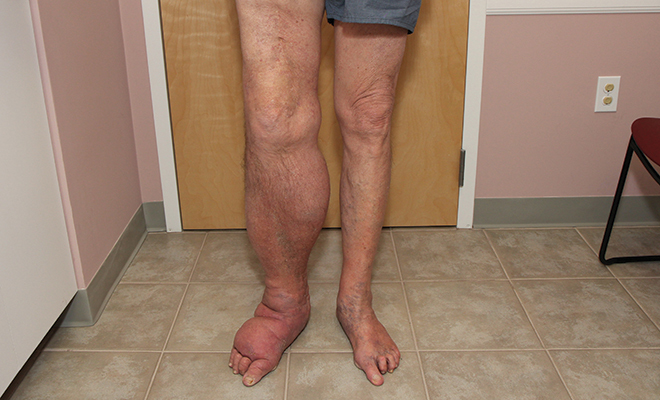
Lymphedema: Just the Facts
We discuss almost any health issue or problem pretty comfortably these days, but we don’t hear much about our lymphatic system in everyday medical news or social media. Its importance is dramatic, however, especially for people suffering from the serious condition of lymphedema.
The lymphatic system keeps the body healthy by circulating protein-rich lymph fluid throughout the body, collecting bacteria, viruses and waste products. The fluid and harmful substances are filtered through lymph nodes; wastes are filtered out by lymphocytes and ultimately flushed from the body. When the lymphatic system becomes congested or clogged, an accumulation of toxins begins and the body is compromised.
What is Lymphedema?
Lymphedema, or lymphatic obstruction, is a long-term condition in which excess fluid, called lymph, collects in tissues, causing swelling, or edema. Since the lymphatic system is a part of the circulatory system and is vital for immune function, a blockage of this system is termed lymphedema. Typically, the most commonly affected body areas are the arms and the legs and often both arms or both legs are affected. Some patients can experience swelling of the chest, head or genitals.
Primary lymphedema, often called congenital lymphedema, occurs at birth or around puberty. This type of lymphedema is rare, affecting about 1 in 6,000 people.
Secondary lymphedema is more common and occurs from a life event or functional impairment such as a trauma to the body, infection or injury that hurts the lymphatic system, and as a result of obesity. Lymphedema may come about after cancer treatment, often radiation therapy or after the removal of lymph nodes, which may damage the lymphatic system. This type of lymphedema is more common in women than men and affects about 1 in 1,000 people.
Signs and Symptoms
Symptoms of lymphedema may include a heavy sensation or tightening in the limb or limbs, decreased range of motion or flexibility in the hand, wrist, foot or ankle or a feeling of tightness in clothes in certain body areas. Many patients notice other items that they wear on their body, such as a wristwatch, jewelry or ring, feeling tighter. Swelling in the limbs is an important sign of lymphedema, and often fingers and toes can be affected. While some patients experience slight changes in limb size, others will have more severe swelling. Some patients experience severe fatigue and others’ skin may thicken and harden, with blisters or growths appearing on the skin.
Treating Lymphedema
Although lymphedema is incurable, with the right treatment it can be controlled for each patient. Ongoing research focuses on reducing the symptoms such as swelling and controlling the pain. Some of the most successful lymphedema treatments are fairly simple.
Light to moderate exercise leads the list as a controlling factor in pain management for lymphedema sufferers. Moving the affected limbs not only encourages lymph fluid drainage, but it keeps the body stronger to manage everyday tasks. Exercises should not be overstrenuous, but should focus on contracting the affected muscles.
Thoroughly wrapping or bandaging the affected limbs allows fluid to flow toward the trunk of the body. The wrap should be tightest at the fingers or toes and get looser as it moves up the arm or leg.
A specially trained massage therapist can perform a technique called manual lymph drainage to encourage lymph fluid flow. People with skin infections or blood clots should avoid massage.
Long sleeves or stockings made to compress affected arms or legs encourage the flow of the lymph fluid out of the affected limb. Patients should wear compression garments when exercising the affected limb. Some patients may need a custom-made compression garment.
Complete Decongestive Therapy is an intensive program that combines several treatment approaches. Two stages occur in CDT. The first stage is typically performed as aggressive treatment with a therapist, while the second stage allows patients to maintain the results of the initial intensive phase on their own. In general, CDT isn’t recommended for people who have high blood pressure, diabetes, paralysis, heart failure, blood clots or acute infections.
Professional Help
Although there are no mandated training standards for lymphedema therapists, doctors, nurses, physical and occupational therapists and licensed massage therapists who are certified through the Lymphology Association of North America have completed a standards and testing system. This certification denotes a particular level of training, knowledge and experience with treating lymphedema.
The length of treatment for lymphedema sufferers is determined by the stage of disease and how the body responds to treatment. Most people experience lymphedema dynamically, with their condition changing continually over time, as they age and as their body responds to treatment.
Early diagnosis and treatment of lymphedema are the most helpful steps to combating or at least stabilizing the condition. Many treatments can ensure patients more independence and confidence as they manage lymphedema long term for a healthier, happier, more productive life. ■
Sources: clt-lana.org, lymphnet.org, medicalnewstoday.com and mayoclinic.org.







